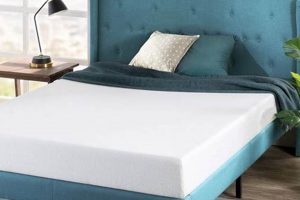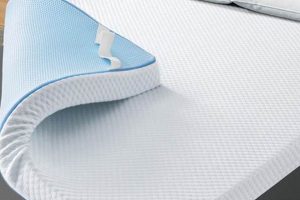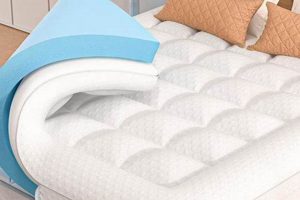A cushioning layer, approximately 3 inches thick, designed to be placed atop an existing bed, enhances comfort and support. Constructed from foam materials, it modifies the feel of a sleep surface. As an example, a firmer mattress can be softened through the addition of such a layer.
The use of these additions provides several advantages, including improved sleep quality through pressure relief and enhanced spinal alignment. They can also extend the lifespan of the underlying mattress by reducing wear and tear. Historically, variations in bedding materials have been utilized to customize sleep surfaces and achieve optimal comfort levels.
The following sections will delve deeper into various aspects related to this sleep product, encompassing factors to consider when selecting one, the different types of foam available, and its proper care and maintenance procedures.
Selecting a 3 Inch Mattress Foam Topper
This section provides essential guidelines for choosing a suitable sleep surface enhancement, ensuring optimal comfort and support based on individual needs.
Tip 1: Evaluate Density. Higher density foam generally offers increased durability and support. Consider a denser option for enhanced longevity and resistance to compression.
Tip 2: Consider Foam Type. Memory foam, latex foam, and polyurethane foam each possess unique characteristics. Memory foam contours to the body, while latex offers responsiveness and breathability. Polyurethane is a more budget-friendly option with varying levels of support.
Tip 3: Assess Firmness Level. The appropriate firmness depends on individual sleep preferences and body weight. Lighter individuals may prefer a softer option, while heavier individuals might benefit from a firmer one for adequate support.
Tip 4: Review Thickness. While the product discussed is 3 inches, understanding the interaction between thickness and foam density is crucial. A lower density 3-inch model may not offer the same level of support as a higher density option.
Tip 5: Check for Certifications. Look for certifications such as CertiPUR-US, which indicates the foam has been tested for harmful substances and meets specific standards for emissions and durability.
Tip 6: Inquire About Warranty. A comprehensive warranty provides assurance regarding the product’s quality and lifespan. Review the terms and conditions to understand coverage details.
Tip 7: Consider Off-Gassing. Some foam products may emit a slight odor upon initial unpacking. Allow adequate ventilation for several days to minimize any potential off-gassing.
Prioritizing these factors facilitates a more informed purchase decision, leading to improved sleep quality and overall comfort.
The subsequent sections will provide information on maintenance, cleaning, and prolonging the life of a selected sleep enhancement.
1. Density
Density, measured in pounds per cubic foot (PCF), is a crucial determinant of the performance and longevity of a 3 inch mattress foam topper. Higher density foam provides increased support and resistance to compression, translating to a longer lifespan and reduced likelihood of sagging. Conversely, lower density foam, while often more affordable, compresses more readily, offering diminished support and a shorter lifespan. For instance, a 3 inch memory foam topper with a density of 4 PCF will generally offer superior support and durability compared to an identical topper with a density of 2 PCF.
The impact of density is particularly noticeable in areas of concentrated pressure, such as the hips and shoulders. High-density foam distributes weight more effectively, minimizing pressure points and contributing to spinal alignment. This is especially relevant for individuals experiencing back pain or seeking enhanced orthopedic support. Furthermore, the practical implications extend to the topper’s resistance to body impressions over time; high-density materials maintain their shape and loft more effectively than lower-density counterparts, ensuring consistent comfort and support throughout its lifespan.
In summary, the density of a 3 inch mattress foam topper directly correlates with its support, durability, and long-term performance. Selecting a topper with adequate density is a vital consideration for individuals seeking optimal sleep quality and a lasting investment. However, challenges can arise in accurately assessing density, as manufacturers may not always provide this specification. Consequently, relying on customer reviews and independent testing data can be invaluable in making an informed decision.
2. Foam Type
The material composition of a 3 inch mattress foam topper, specifically the type of foam used, fundamentally dictates its performance characteristics, influencing comfort, support, temperature regulation, and durability.
- Memory Foam
Memory foam, also known as viscoelastic foam, conforms closely to the body’s contours, distributing weight and alleviating pressure points. This characteristic can significantly enhance comfort, particularly for side sleepers or individuals with joint pain. However, traditional memory foam can retain heat, potentially leading to discomfort in warmer climates. Advanced formulations, such as gel-infused memory foam, aim to mitigate this issue by promoting airflow and dissipating heat.
- Latex Foam
Latex foam offers a responsive and resilient feel, providing a balance of support and comfort. Derived from either natural rubber or synthetic materials, latex exhibits excellent breathability and temperature regulation. Natural latex, in particular, is known for its durability and resistance to dust mites and allergens, making it a suitable choice for individuals with sensitivities. Dunlop and Talalay are the two primary processing methods for latex foam, resulting in variations in density and firmness.
- Polyurethane Foam
Polyurethane foam is a cost-effective option commonly used in mattress toppers. Its characteristics vary depending on density and composition, ranging from soft and conforming to firm and supportive. While polyurethane foam is generally less durable than memory foam or latex, high-density variants can offer satisfactory support and longevity. Open-cell polyurethane foam promotes airflow, enhancing breathability compared to closed-cell alternatives.
- Gel-Infused Foam
Gel-infused foam, typically memory foam or polyurethane foam incorporating gel particles, aims to improve temperature regulation. The gel absorbs and dissipates heat, creating a cooler sleep surface. The effectiveness of gel infusion varies depending on the type and concentration of gel used. Some gel-infused toppers also incorporate phase-change materials that actively regulate temperature based on environmental conditions.
The choice of foam type is a critical factor when selecting a 3 inch mattress foam topper. Each material offers a distinct set of characteristics that cater to varying sleep preferences and needs. Individuals should carefully consider their priorities regarding comfort, support, temperature regulation, and durability to determine the most suitable foam type.
3. Firmness
Firmness, in the context of a 3 inch mattress foam topper, directly influences the perceived comfort and support provided by the sleep surface. It represents the degree of resistance the foam offers to compression, ranging from soft and plush to firm and unyielding. The selection of an appropriate firmness level is critical for optimizing spinal alignment, pressure relief, and overall sleep quality.
- Impact on Spinal Alignment
The firmness of a topper affects spinal alignment. A topper that is too soft may cause the spine to bow, particularly for stomach sleepers, leading to back pain. Conversely, a topper that is too firm may not allow the spine to assume its natural curvature, especially for side sleepers. The ideal firmness level maintains the spine’s natural alignment, minimizing strain and promoting restful sleep. The suitability of firmness hinges greatly on the individuals sleeping posture.
- Pressure Point Relief
Firmness affects pressure point relief. Softer toppers conform to the bodys contours, distributing weight and reducing pressure on areas such as the hips and shoulders. This is particularly beneficial for individuals with arthritis or other joint pain. Firmer toppers, while providing greater support, may not offer sufficient pressure relief for some individuals, leading to discomfort. Therefore, the need for pressure relief should be weighed against support.
- Influence on Body Weight and Sleeping Position
Body weight and sleeping position strongly influence the appropriate firmness level. Heavier individuals typically require a firmer topper to prevent excessive sinking and maintain spinal alignment. Lighter individuals may find softer toppers more comfortable. Side sleepers generally benefit from softer toppers that allow the shoulder and hip to sink in, while back sleepers may prefer medium-firm toppers for balanced support. Stomach sleepers often require firmer toppers to prevent arching of the back.
- Material Interaction
The perceived firmness is influenced by the type of foam used. A latex foam topper with a medium firmness rating may feel different than a memory foam topper with the same rating. Memory foam tends to contour more closely to the body, providing a “sinking” sensation, while latex offers a more responsive and buoyant feel. The interaction between material and firmness should be considered to match individual preferences.
In summary, the selection of an appropriate firmness level for a 3 inch mattress foam topper involves careful consideration of spinal alignment, pressure point relief, body weight, sleeping position, and the inherent characteristics of the foam material. An informed decision maximizes the potential benefits of the topper, contributing to improved sleep quality and overall well-being. However, personal preference remains a significant factor, highlighting the importance of trying different firmness levels when possible.
4. Thickness
The defining characteristic of a “3 inch mattress foam topper” is its vertical dimension, namely its thickness of three inches. This dimension is not arbitrary but rather represents a specific compromise between providing sufficient cushioning and support while avoiding excessive elevation of the sleep surface. The thickness directly influences the topper’s ability to contour to the body, alleviate pressure points, and isolate motion. A thinner topper, for example, might offer minimal cushioning, failing to adequately reduce pressure on areas such as the hips and shoulders. Conversely, a thicker topper, exceeding 3 inches, could potentially create an unstable sleep surface or interfere with the proper fit of bedding. A 3-inch thickness, in many cases, delivers a balanced outcome.
The practical significance of this thickness is evident in its impact on spinal alignment. A 3-inch foam layer can conform to the body’s natural curves, promoting proper alignment and reducing strain on the back and neck. For instance, an individual experiencing discomfort on a firm mattress may find that the addition of a 3-inch memory foam topper provides the necessary cushioning to relieve pressure and maintain a neutral spine position. Similarly, the thickness plays a role in motion isolation. The foam material absorbs movement, minimizing disturbances for sleeping partners. The 3-inch dimension allows for sufficient material to dampen motion transfer effectively, contributing to uninterrupted sleep. Real-life examples of application can include college dorm or hospital beds that need comfort and support.
In conclusion, the 3-inch thickness of a mattress foam topper is a critical design element that balances comfort, support, and practicality. It directly affects the topper’s ability to alleviate pressure points, promote spinal alignment, and isolate motion. While individual preferences may vary, understanding the importance of this dimension is essential for selecting a topper that meets specific needs and contributes to improved sleep quality. Challenges may arise in assessing the true thickness of a topper due to variations in manufacturing processes or compression of the foam during shipping; however, verifying the specified thickness prior to purchase is advisable.
5. Certifications
Certifications serve as independent verification of a 3 inch mattress foam topper’s adherence to specific safety, performance, or environmental standards. The presence of relevant certifications on a sleep product provides consumers with quantifiable assurances regarding its composition and potential impact. For instance, a CertiPUR-US certification indicates that the foam used in the topper has been tested for harmful substances such as formaldehyde, heavy metals, and ozone depleters. Similarly, a Global Organic Latex Standard (GOLS) certification ensures that a latex foam topper contains a specified percentage of organic latex material. Without such certifications, consumers lack objective data to assess the product’s safety and environmental impact, relying solely on manufacturer claims.
The practical significance of certifications extends beyond mere compliance. They represent a manufacturer’s commitment to quality and transparency. For example, a 3 inch memory foam topper bearing the OEKO-TEX Standard 100 certification signifies that every component of the product, from the fabric cover to the foam itself, has been tested for harmful substances. This is particularly relevant for individuals with allergies or sensitivities, who may be more susceptible to adverse reactions from unregulated materials. Real-world applications of this knowledge can involve specific purchasing decisions to mitigate health risks. Similarly, certifications linked to durability and performance can justify a higher price point, signaling a longer-lasting, more reliable product. Therefore, the absence of certifications doesn’t necessarily indicate an unsafe product, but their presence offers a tangible benchmark of quality and safety.
In conclusion, certifications provide a crucial link between manufacturer claims and verifiable product characteristics for a 3 inch mattress foam topper. They act as a quality assurance mechanism, enabling consumers to make informed decisions based on objective data. While the interpretation of different certifications can be complex, understanding their basic purpose and the specific standards they represent is essential for selecting a safe, high-quality sleep surface enhancement. Potential challenges involve deciphering the varying levels of rigor and scope associated with different certifications; however, resources from reputable consumer organizations can assist in navigating this complexity.
6. Warranty
The warranty associated with a 3 inch mattress foam topper represents a manufacturer’s pledge regarding the product’s lifespan and performance. It serves as a safeguard against defects in materials and workmanship, providing recourse for consumers in the event of premature failure. Understanding the terms and conditions of a warranty is crucial before purchase.
- Coverage Duration and Scope
Warranty duration typically ranges from one year to a decade, with longer periods suggesting greater confidence in the product’s longevity. The scope of coverage specifies the types of defects or issues that are eligible for remediation. For example, a warranty may cover sagging or indentations exceeding a certain depth, but exclude damage resulting from misuse or improper care. Understanding these limitations is vital.
- Pro-rated vs. Non-prorated Terms
Warranties can be either pro-rated or non-prorated. A non-prorated warranty covers the full cost of repair or replacement within the specified period. A pro-rated warranty, however, reduces the coverage amount over time. For instance, after several years, the consumer may be responsible for a percentage of the replacement cost, reflecting the depreciated value of the product. Pro-rated terms diminish the value of the warranty over its lifespan.
- Claim Procedures and Requirements
Initiating a warranty claim typically requires the consumer to provide proof of purchase, a detailed description of the defect, and potentially photographic evidence. The manufacturer may require the topper to be returned for inspection. Consumers should familiarize themselves with the specific claim procedures outlined in the warranty documentation to ensure a smooth resolution process. Failure to adhere to these procedures could invalidate the claim.
- Exclusions and Limitations
Warranties commonly exclude certain conditions, such as physical damage, stains, burns, or damage resulting from improper cleaning or use with an incompatible bed frame. “Comfort guarantees,” allowing returns based solely on subjective comfort preferences, are distinct from warranties and are not always offered. Consumers should carefully review the exclusions and limitations section of the warranty to understand the extent of coverage and any potential liabilities.
The warranty on a 3 inch mattress foam topper offers a degree of protection against manufacturing defects and premature degradation. However, the specific terms and conditions, including the duration, scope, pro-rated or non-prorated nature, claim procedures, and exclusions, significantly influence the actual value of the warranty. A thorough review of the warranty documentation is essential to ensure that it aligns with the consumer’s expectations and provides adequate recourse in the event of product failure.
7. Off-Gassing
Off-gassing, the release of volatile organic compounds (VOCs) from materials, represents a relevant consideration in the selection and use of a 3 inch mattress foam topper. These compounds, present in varying concentrations in foam products, can emit odors and, in some instances, pose potential health concerns. This phenomenon is particularly pronounced in new foam items and diminishes over time. Understanding the nature and mitigation of off-gassing is therefore prudent.
- Composition of VOCs
VOCs released during off-gassing from a 3 inch mattress foam topper typically include chemicals used in the manufacturing process, such as blowing agents, adhesives, and flame retardants. The specific types and concentrations of VOCs vary depending on the foam type (memory foam, latex, polyurethane) and the manufacturer’s formulation. While many VOCs are considered harmless at low concentrations, some individuals may experience sensitivities or adverse reactions, such as headaches, nausea, or respiratory irritation.
- Factors Influencing Off-Gassing
Several factors influence the intensity and duration of off-gassing. Higher ambient temperatures accelerate the release of VOCs. Similarly, the density and formulation of the foam material play a role. Higher density foams may initially exhibit more pronounced off-gassing due to the greater volume of material. Furthermore, products that have been tightly packaged or stored for extended periods may exhibit more noticeable odors upon initial unpacking.
- Mitigation Strategies
Several strategies can mitigate the effects of off-gassing. Allowing the 3 inch mattress foam topper to air out in a well-ventilated area for several days or weeks before use is recommended. This promotes the dissipation of VOCs and reduces odor intensity. Washing the topper’s cover, if removable, can further minimize residual chemicals. Additionally, selecting toppers certified by organizations such as CertiPUR-US, which restrict the use of certain VOCs, can reduce potential exposure.
- Long-Term Considerations
While the initial off-gassing period is typically the most noticeable, low-level VOC emissions can persist for an extended duration. However, the concentrations of these emissions generally decrease significantly over time. Individuals with heightened chemical sensitivities may consider using an air purifier with a VOC filter to further reduce potential exposure. Ultimately, the long-term impact of off-gassing from a 3 inch mattress foam topper depends on individual sensitivities and the specific characteristics of the product.
The off-gassing phenomenon, while a common characteristic of new foam products, can be managed through informed product selection and appropriate mitigation strategies. Considering the factors that influence off-gassing and implementing preventative measures contributes to a healthier sleep environment when using a 3 inch mattress foam topper.
Frequently Asked Questions
This section addresses common inquiries regarding the use, care, and selection of a mattress foam topper, aiming to provide comprehensive and objective information.
Question 1: Will a 3 inch mattress foam topper eliminate the need for a new mattress?
A topper can enhance comfort, but will not rectify severe underlying mattress support issues. Significant sagging or coil damage necessitate mattress replacement.
Question 2: How does a 3 inch mattress foam topper affect temperature regulation?
Some foam types, particularly traditional memory foam, can retain heat. Gel-infused or open-cell foams offer improved airflow and temperature regulation.
Question 3: What is the expected lifespan of a 3 inch mattress foam topper?
Lifespan depends on foam density, usage, and care. High-density foams typically last longer, ranging from three to five years with proper maintenance.
Question 4: Can a 3 inch mattress foam topper exacerbate allergies?
Some individuals are sensitive to VOCs emitted by new foam. Certifications like OEKO-TEX indicate lower VOC levels. Hypoallergenic covers can mitigate allergen accumulation.
Question 5: How should a 3 inch mattress foam topper be cleaned?
Spot cleaning with mild detergent and water is recommended. Avoid harsh chemicals or saturating the foam. A waterproof mattress protector prevents stains and moisture damage.
Question 6: Does a 3 inch mattress foam topper require a special bed frame?
A standard bed frame is generally sufficient. However, ensure the frame provides adequate support to prevent sagging, which can affect topper performance.
Selecting a suitable 3 inch mattress foam topper depends on individual needs. Prioritizing material quality and maintenance facilitates optimal use.
The next segment will summarize the salient considerations discussed within this document.
Concluding Remarks
This document provided an extensive exploration of the 3 inch mattress foam topper. Key aspects addressed included material composition (memory foam, latex, polyurethane), density considerations, firmness levels, certification importance, warranty implications, and the potential for off-gassing. Furthermore, the influence of thickness on comfort and support was emphasized, alongside best practices for cleaning and maintenance. The information presented offers a foundation for informed purchasing decisions.
The selection of a 3 inch mattress foam topper represents a nuanced evaluation of individual needs and product characteristics. Careful consideration of the factors outlined herein is essential for maximizing sleep quality and ensuring long-term satisfaction. Ultimately, the effective utilization of this information empowers consumers to make choices that align with their specific requirements and promote restful sleep.


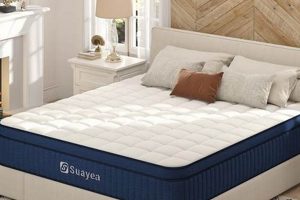
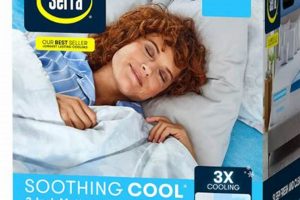
![Best Twin Memory Foam Mattress 8 Inch For [Better Sleep] Organic & Natural Mattress Buyer’s Guide: Non-Toxic Sleep Solutions Best Twin Memory Foam Mattress 8 Inch For [Better Sleep] | Organic & Natural Mattress Buyer’s Guide: Non-Toxic Sleep Solutions](https://mattressworldpa.com/wp-content/uploads/2025/07/th-3687-300x200.jpg)
